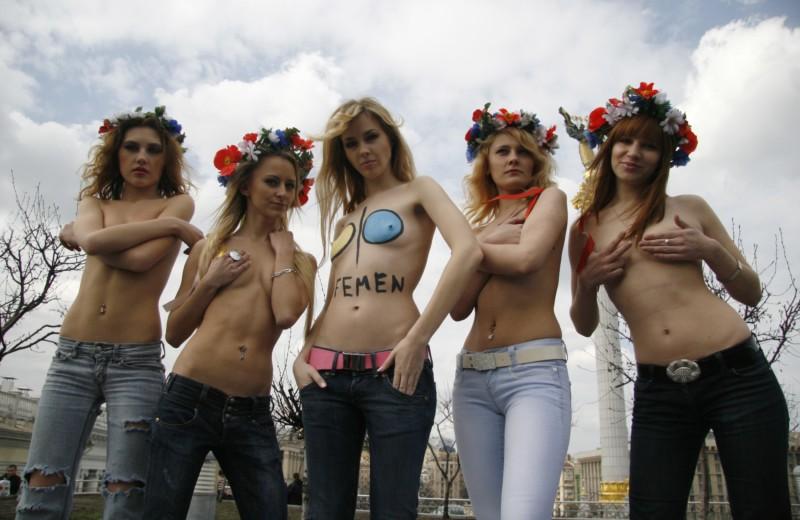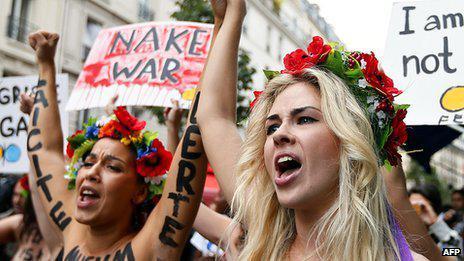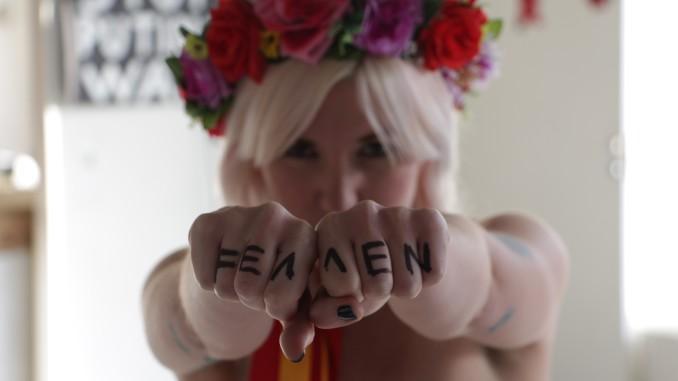
FEMEN: "My Body is a Weapon!"
FEMEN is a well-known sextremist organisation. Their reputation is sometimes determined not by what they stand for, but by the methods they use. The group draws media attention by showing their half-naked bodies in public. But who are these provocative young women? Is FEMEN actually feminist?
What we know about FEMEN
FEMEN, founded 10 years ago in Kyiv, Ukraine, was created by two people: Victor Svyatski and Anna Hutsol. This has made many people wonder from the very beginning: a man as an organizer, who was never actually spotted in the demonstrations, stripping down, as the women do? Some years after the founding he left FEMEN, and in interviews the female participants of the movement have complained about Svyatski. It seems like FEMEN have revised what the leader of their movement should be like.
FEMEN’s goal is “Complete victory over patriarchy”, which they try to achieve through Sextremism - “a fundamentally new form of women’s feminist action is developed by FEMEN (...) FEMEN has brought her methods and utopian dreams into this new feminist era that continues to grow to unite” (femen.org). Sextremism among female activists is a phenomenon mostly spread in Post-Soviet countries. Sextremism "... is female sexuality rebelling against patriarchy and embodied in the extremal political direct action events." FEMEN describe their ideology as follows:
- “Sextremism
- Atheism
- Feminism”
FEMEN started as a small community in 2008 in Kyiv, recruiting participants by messaging them through Vk, the social media popular in Eastern Europe, or the so-called 'Russian Facebook'. In their messages they asked girls if they wanted to join fighting prostitution and sex tourism - this is how the movement gained its first followers.

FEMEN: how they started
FEMEN keeps its methods of recruiting, development, and the number of participants a secret nowadays. Alisa Vinogradova, the group’s lead activist makes an analogy with ISIS: FEMEN’s structure is a secret, the only criterion is that a woman needs to be sexy - but their breast size does not matter.
Starting with protests for women's rights and against violence, "... a worldwide issue, with intimate-partner physical violence, sexual violence, or both, affecting one in three women, leading to substantial health effects that are important determinants of morbidity and mortality" (García-Moreno et al, 2015), as well as prostitution and sex tourism, they soon were involved in key political events highlighted by media. Their protests involving blasphemy attracted the most criticism. Inna Shevchenko, the leader of the movement, states in one of her interviews that “where religion is starting the feminism is finishing. We are definitely an atheistic movement, we are an anti-religious movement”.
FEMEN gained popularity due to their political protests. There are 3 top politicians that FEMEN liked to protest against: Putin, Erdogan and Berlusconi. The activists got the closest to the former during his meeting with Angela Merkel. By now, it is one of the group’s most famous acts.

FEMEN's activist trying to attract Putin's attention
Because of their active critical involvement in politics and acts of vandalism, some of the participants had to flee Kyiv and seek asylum in France. FEMEN started growing with activists in Spain, the USA, France, Turkey, Tunisia, Sweden, Canada and other countries.
Inna Shevchenko says that the group is rather ambitious: even though they face a lot of criticism, she keeps receiving positive responses from girls all around the world and countries where expressing oneself is prohibited, especially for women. Sometimes "The forms of violence experienced by this population are frequently hidden, socially sanctioned, and not recognised or adequately addressed by the institutions that should respond" (García-Moreno et al, 2015). Hearing the voices of women from such places serves as an inspiration to continue for Shevchenko.

One of the movement's ex-participant, Aleksandra Shevchenko
The website of the movement states that girls do undergo a specific preparation before participating in protests: “FEMEN female activists are the women with special training, physically and psychologically ready to implement the humanitarian tasks of any degree of complexity and level of provocation. FEMEN activists are ready to withstand repressions against them and are propelled by the ideological cause alone. FEMEN is the special force of feminism, its spearhead militant unit, modern incarnation of fearless and free Amazons.”
As they define themselves on their website, “FEMEN is an international women’s movement of brave topless female activists painted with the slogans and crowned with flowers”. A little group from Ukraine has grown into an international movement with its headquarters and the FEMEN training camp in Paris. What is left from their motherland, however, is the national flower crown vinok - “a symbol of femininity and proud insubmission, a crown of heroism” (femen.org) - worn by the participants and the belief in women’s rights and power.
Error: feminism not found
It is common to consider FEMEN a radical feminist group. However, many feminists treat FEMEN as outsiders, criticizing their methods of publicly showing off their bodies. The leader of FEMEN, Inna Shevchenko, comments on the matter: “I am for any form of feminism”, which defines the mindset of the organisation.

Conflicts with police
Many feminists do not approve of FEMEN’s sextremist methods. They treat them as a disgrace to the very idea of what feminism is about. One of the most pervasive criticisms is that FEMEN "uses every classic, sexist stereotype that’s been used forever in order to discredit feminists, calling them spoiled, ugly, and ‘unsatisfied’ women; going on to say that “classical feminism looks like [an] old, sick lady.” I’m sorry, who’s ‘spoiled’ again?" - feministcurrent.com. However, FEMEN activists have chosen their form of protest because "...people tend to categorize each other by sex, which activates gender stereotypes..." (Bobbitt- Zeher, 2012) and it is the only way a woman can be heard in the global patriarchal society.
FEMEN defines their use of naked bodies as a statement - the highlighted sexuality is the only role left for females to be noticed by men and “manliness”, to them, is the accepted narrative in the world. They use sexual appeal, expected from women, to draw attention and to make claims about social issues. It is then believed that this is the only way a woman can be heard in contemporary society. FEMEN is, thus, both against the sexualization and using it to protest.
However, the popular opinion is that “I am not opposed to boobs. Rather, I am opposed to women’s bodies constantly being objectified and sexualized. I am also opposed to the fact that nobody gives a shit about women or feminism unless women and feminism look like a beer commercial or a burlesque show” (Murphy, 2012). Yes, FEMEN are against women’s constant sexualization. However, they are criticized for their methods and are said to promote attention to the sexual appeal of women.

"Naked war"
In general, the popular opinion regarding FEMEN's protests is that after making headlines in the beginning of the movement's activity, and being famous for ruining some political events, the movement started fading away. Many say that it was not about feminism, or even that it had nothing to do with it. Murphy (2012) therefore continues: "Not only are Shevchenko’s arguments convoluted, but the animosity and disrespect she conveys about feminists and the feminist movement shows, undeniably, FEMEN’s lack of connection to this movement."
FEMEN’s strategy is complex and uncontrolled. Murphy (2012) quotes Sara Yasin: “I have absolutely no problem with nudity… The issue with FEMEN is that they have no point.” Yasin continues: “It’s very interesting to call them radical, because they’re actually not radical. They’re just going out and pushing the exact same norms that have been thrown at us for centuries”. FEMEN, therefore, is not only criticized for naked bodies, but for not using their sources right and making no clear point.
Sextremism: expectations vs. reality
While the method of showing the naked body does keep attention alive, FEMEN changed drastically while moving from Ukraine to the international level. The movement started participating only in events which gained the most media attention. This is connected to the structural and ideological changes within the group
The primary idea of FEMEN, according to Oleksandra Shevchenko, was to take the appearance of Barbie - the sexualized object in which men see no threat - and give a voice to the body. Olivier Goujon adds that the core doctrine of sextremism has disappeared, and what is left is just the method.
The transformations within the group were inevitable. Many of FEMEN’s original participants abandoned the movement in the recent years. Goujon continues that political radicalism in combination with sexuality is no longer there, but only the naked body.

FEMEN
FEMEN and the reproducation of the male gaze
"Indeed, surveillance of women's bodies constitutes perhaps the largest type of media content across all genres and media forms" (Gill, 2007). FEMEN confronts this structure using their bodies as a voice to bring about change. However, they are also criticized for doing so.
Some say that with time the group started having showing off their bodies and attending highly mediatized events as their primary goals. Thus it is not clear anymore whether they pursue sextremism, or show naked breasts because it became the group's main feature they get recognized by.
Using their bodies to be noticed, however, is not the main point of criticism against them. What really matters are the things they actually do, or not do.
Despite serious conflicts with police, FEMEN continues to grow by operating and recruiting in new countries and does not stop. In the end, if women’s rights were respected from the very beginning, there would be no reason to protest.
References
Bobbitt-Zeher, D. (2011). GENDER DISCRIMINATION AT WORK: Connecting Gender Stereotypes, Institutional Policies, and Gender Composition of Workplace. Gender & Society. The Ohio State University.
Cheryan, S., Master, A., Meltzoff, A. N. (2015). Cultural stereotypes as gatekeepers: increasing girls’ interest in computer science and engineering by diversifying stereotypes. Frontiers in psychology. University of Washington.
Euronews. (Published on Jun 21, 2013). Femen's breast bearing: firebrand feminism or foolish fad? - italk. (Inna Shevchenko).
FEMEN. (2018). Femen: About us.
Gill, R. (2007). Postfeminist Media. Elements of a sensibility. SAGE Publications. European Journal of Cultural Studies.
Murphy, M. (2012). There is a wrong way to do feminism. And Femen is doing it wrong. Feminist Current.
Shevchenko, O., Goujon, O. (27 October, 2017). Соосновательница Femen Саша Шевченко: «Не обманывайтесь, Femen больше нет». (Stroganova, A., Dmitrieva, O.). RFI.
Shevchenko, I. (8 November, 2013). Femen leader Inna Shevchenko: 'I'm for any form of feminism'. (Aitkenhead, D.).
TEDx Talks. (Published on Jul 29, 2015). I will not stop speaking out loud | Inna Shevchenko | TEDxKalamata.
Vinogradova, A. (24 November, 2017). Активистка Femen: Размер груди у нас не имеет значения. (Rasenkova, M.). Vesti.